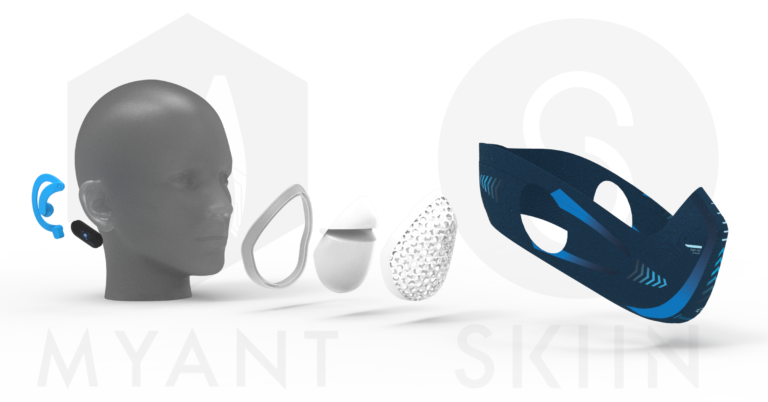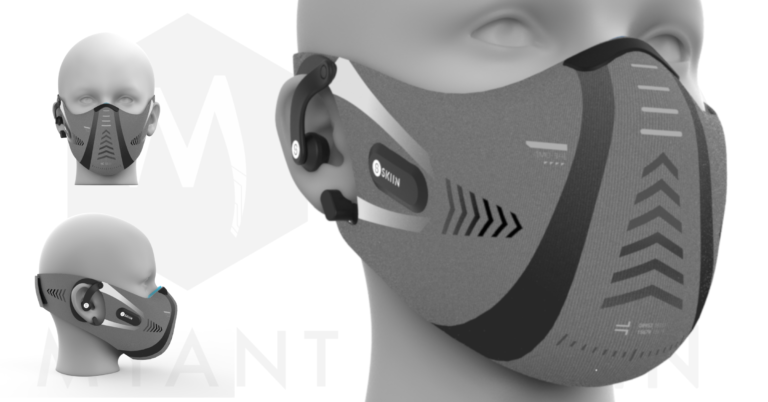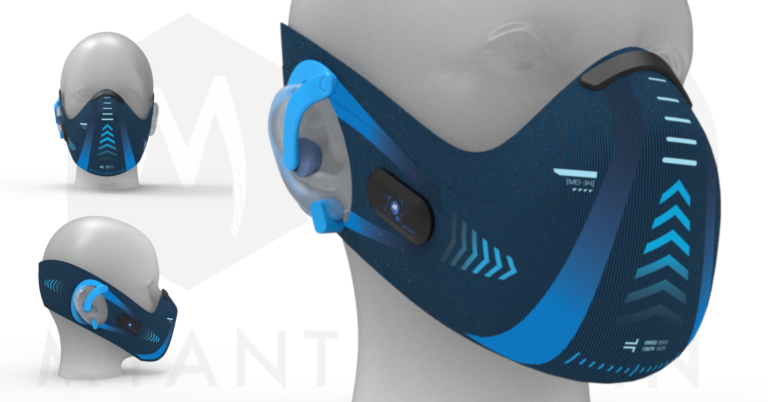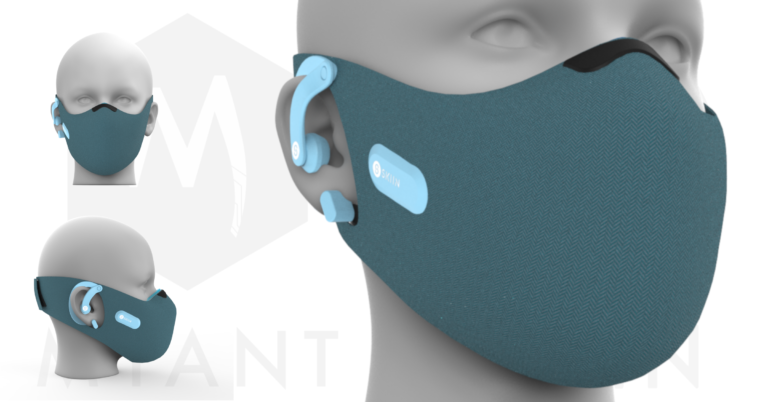Myant Inc., a global pioneer in textile computing, has unveiled concept designs for connected PPE that utilize VOC sensing, enabling new ways of holistically assessing health and performance as part of an expanding interconnected system of biometric garments being realized by the company.
As the idea of wearing PPE evolved from a reactionary preventative measure to an integral part of daily living in the post-COVID world, Myant began to envision ways that a connected biometric sensing mask could integrate into the company’s broader vision for Skiin a network of interconnected biometric garments that span across the different spheres of life.
By virtue of being in close proximity to the nose and mouth, the mask form factor presents an opportunity for a connected textile to collect data on emissions from the respiratory system via volatile organic compound (VOC) sensing, providing new ways to assess health and performance for the user, Myant explains.
The three patent pending mask concepts, designed for healthcare, fitness, and workplace use cases, serve as a guiding vision for the development of the company’s first connected biometric mask to be commercialized later this year under Myant’s consumer brand Skiin.
According to Myant, this development points the way towards a future where functionalized textiles and garments are pervasive throughout daily life, acting as a continuous ambient interface to the human body that helps all people in society live healthier, higher performance, safer, and more productive lives.
Protecting in new ways with connected biometric sensing PPE

The connected mask concepts are modular by design, featuring an N95-level filtration layer positioned on top of a nose-bridge that separates airflow coming from the nose and the mouth, and a flexible silicone seal. The components are held in place by a knitted textile cover that includes heated yarns and electrostatic yarns that enhance protection against infectious agents, as well as temperature sensing yarns that enable sensing of respiration rate.
These yarns draw power through conductive yarns that connect to a module which sends data via BLE to the user’s nearby mobile device. Additional sensing is enabled through integrated VOC sensor, sweat and saliva sensor, carbon dioxide sensor (enabling V02 Max measurement for the fitness mask), an in-ear IR sensor (for body temperature measurement), and a PPG sensing ear clip (for HRV and SpO2). The modular design also allows for rapid disassembly and cleaning via hand washing, use of disinfecting sprays, or autoclaving, adds Myant. Data captured by the mask is sent to the Myant Platform where it, along with other data captured by garments powered by Skiin, are holistically assessed by AI to generate meaningful insights to improve health and performance.
Myant says that the addition of biochemical sensing rounds out its existing biometric sensing capabilities (biomechanics, electrophysiology, haemodynamics, and now biochemistry), enabling textiles that are ‘powered by Skiin’ to provide an even more comprehensive view into the human body across different spheres of life, including within healthcare, fitness, and workplace settings. Myant has developed three concept designs mapping to these applications that will serve as a guide in its development of a consumer-ready connected biometric mask to be launched in Q4 2020 under its connected clothing brand Skiin.
Connected PPE for protection and biometric monitoring in healthcare settings

This connected biometric PPE concept was designed for healthcare settings like clinics or hospitals where care providers, patients and their loved ones all benefit from protection and biometric monitoring. Every person inside a medical setting is a potential source of infection, Myant explains, and the ubiquity of masks makes them an ideal way to create a comprehensive view of the collective and individual health of a healthcare facility.
With integrated VOC sensing to detect airborne infectious agents being emitted from the user’s respiratory system, an in-ear infrared (IR) sensor to provide accurate continuous tracking of body temperature, temperature sensing yarns that captures respiration, and an ear-clip with an integrated PPG sensor to track SpO2 and HRV, the connected mask becomes a powerful tool to understand what is happening inside the patient or the care provider’s body, the company adds.
All sensors draw power through conductive yarns in the textile from a Skiin pod (common amongst all garments that are powered by Skiin) which communicates with a nearby mobile device via BLE. The data is then sent to the Myant Platform which uses AI to triage the set of biometric symptoms to look for early signs of infection, enabling a more predictive approach to care. These medical-grade masks are knitted to meet N95 standards and are modular in design, allowing for individual parts to be wiped down, sprayed, or autoclaved.
Connected PPE that improves rather than hinders performance

The conversation around wearing a mask while exercising has largely been a discussion about which masks are least impactful on the user’s performance, Myant comments. “Researchers from the University of Leipzig in Germany conducted a prospective cross-over study to investigate the impact of N95 and surgical masks on heart/lung responses of subjects during an incremental cycling test to exhaustion, concluding that ventilation, cardiopulmonary exercise capacity and comfort are reduced by surgical masks and highly impaired by N95 face masks in healthy individuals,” Myant explains.
“Another study published in the British Journal of Sports Medicine suggests that air-flow restricting masks can increase the rate of perceived exertion and decrease performance during resistance training,” Myant adds.
Accordingly, with masks becoming an unavoidable part of all spheres of life, including fitness, Myant looked for ways to not only address these issues but to use masks to actually improve performance instead of hindering it.
Myant continues: “One way this concept mitigates the impact of masks on performance is through the modular design, featuring a nose-bridge that isolates the nasal and oral airflows, reducing the ‘recycling’ of oxygen depleted exhaled air back into the system. The silicone seal around the nose and mouth allows the mask to not only protect but function as a way to capture data about the cardiovascular performance of the athlete through measurement of VO2 max and RER monitoring (respiratory exchange ratio).”
In addition to these biochemical sensing capabilities, Myant explains, mbedded IMU sensors on the Skiin pod create an accurate depiction of the athlete’s biomechanical activity while PPG sensing helps track heart rate before, during and after exercise. All this data lives on the Myant Platform where it can be assessed holistically by AI to uncover insights that could improve performance. Data can even be shared with training partners and coaches who can help inspire the athlete to unlock new levels of performance.
Connected PPE to keep workplaces safe and productive

This connected PPE concept was designed with the workplace in mind where a balance between safety and productivity is essential. Since the cost of outbreak can be devastating for both employees and employers, it is incumbent on all stakeholders to ensure that everyone is properly protected, to mitigate risk of exposure, and to remain vigilant for the early signs of infection, Myant articulates.
One common complaint about wearing masks amongst workers, Myant claims, is that ‘recycling’ of air (or breathing air that has been exhaled but trapped inside a mask) leads to workers complaining about fatigue. This mask attempts to address the concern by separating the oral and nasal airflows via the nose-bridge, ensuring that air exhaled from the mouth is not recycled into the body. The N95 filtration level of the textile combined with VOC sensors to identify potential airborne infectious agents and heated yarns that promote the release of ions from copper yarns (known to be detrimental to viruses) all help to provide increased protection, the company adds. The addition of stress sensing, fatigue monitoring, respiration, body temperature and other biometric readings helps to identify early signs of an outbreak that could potentially gravely impact the health, well-being, and productivity of the workforce, Myant concludes.

